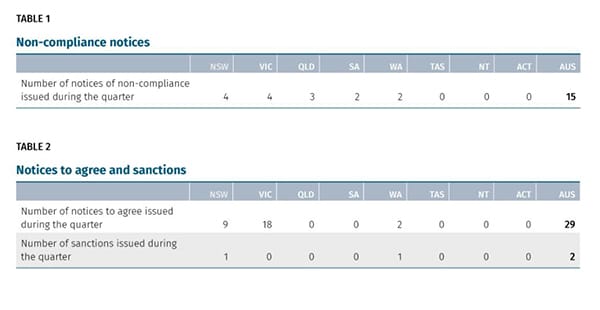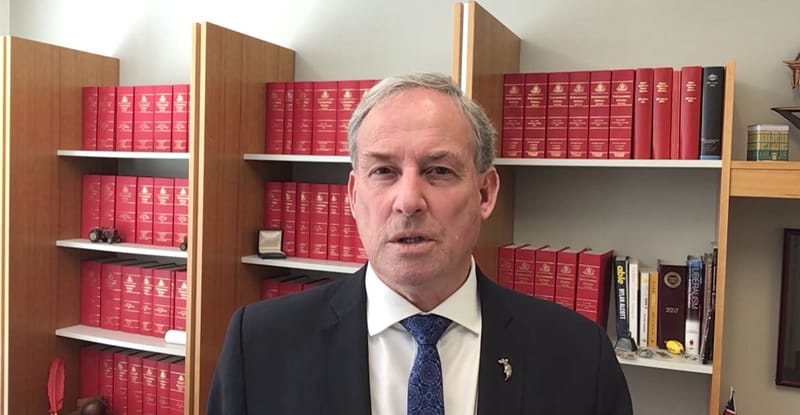Grattan Institute’s Hal Swerissen: ‘big box’ aged care homes out – smaller facilities in. Plus, regional management of sector would avoid “catastrophes” seen in Royal Commission
With the Royal Commission staging its next hearing in three weeks – and calling for submissions on how the aged care system could be financed – the future of the sector is again on the agenda – the Grattan Institute’s Professor Hal Swerissen...

With the Royal Commission staging its next hearing in three weeks – and calling for submissions on how the aged care system could be financed – the future of the sector is again on the agenda – the Grattan Institute’s Professor Hal Swerissen has firm ideas on where we should be heading.
Professor Swerissen speaks from experience. A Visiting Fellow at the independent thinktank, he has held senior executive positions as Pro Vice Chancellor (Regional) and Executive Dean of Health Sciences at La Trobe University.
In the 1990s, he worked as a Senior Adviser to then-Health and Human Services Minister Carmen Lawrence as well as with a State Minister for Disability and has led a range of policy and research studies and inquiries.
Higher contributions needed for aged care
The Professor also gave evidence to the Royal Commission into Aged Care at its home care hearings in March last year, delivering a compelling argument for Australia to streamline the way aged care services is funded – including the need for higher contributions – now (see The Daily COMMISSION 22 March 2019, 22nd edition, for the story).
15 months later and there has been no change – but the Royal Commission has just released a consultation paper on how the system could be funded into the future.
So, what does Professor Swerissen say now about how aged care should be funded – and what are the models he thinks will lead the way moving forward?
System should focus on rights of older people
The Professor says the main issue with the current system is the capped model of funding because it places the Government’s focus on how to keep costs under control and provide services efficiently and to scale.
“It is not as concerned about a rights-based system where the fundamental starting point is that everyone has the right to a decent set of care when they have high level complex needs for a long time,” he said.
In contrast, he points out the disability legislation is much more focused on the rights of people with disabilities and their choices.
Baby Boomers won’t want ‘big boxes’
Professor Swerissen says this cost-controlled, paternalistic approach to aged care will not work in the future.
“The Baby Boomers are about to hit and they are a lot more articulate and educated. There are also a lot more of them and they are not very tolerant of sorts of things that have been happening so there will be pressure to see new models,” he stated.
He says larger ‘big box’ facilities that warehouse older people are not the model that should be pursued.
“Even [Not For Profit] providers are driven to get their costs down; employ the lowest cost staff they can find and manage costs all around the idea of standardisng and driving efficiencies and getting scale. That’s not the driver you want for long term care,” he said, adding: “You want it to be the experience and outcomes that people have.”
Smaller models integrated into community will be key
The Professor points the trend in long-term care in the last three to four years of smaller aged care homes that are integrated into the community – such as the Dutch Humanitas model which focuses on intergenerational living.
While he says the dementia village model does bring a sense of community, he says the real focus will be on scaling back larger facilities and developing a range of different models that will cater to different groups, such as people living with dementia and those from different cultural and ethnic backgrounds.
However, Professor Swerissen says this will require incentives for providers to develop these new models.
More incentives needed for all operators to build new models
For Profit providers must produce a return for shareholders so they aim for scale and standardization to keep their costs under control, he says – but may not get those returns under the existing funding arrangements.
He argues many Not For Profit operators, which are mission-driven, are still paternalistic in their approach and may not be sitting down and working through the different needs of the people they service.
While those who can afford to pay more can choose the environment they want, older Australians with less means “get the big boxes”, the Professor says, or in rural areas, homes that may offer good community interaction but poorer facilities.
Where to start then?
Move to an NDIS-style system of entitlement
To redesign the system, he argues the aged care legislation should be reformed to make it similar to the NDIS, which is based on the principle that everyone is entitled to the reasonable necessary supports for their needs.
Services then need to be planned around the individual, Professor Swerissen states.
He points out that under the current system, an older person must undergo an eligibility assessment to determine their entitlements, be assessed for residential care or a Home Care Package and be allocated a facility or provider – all before a care plan is actually developed.
“There is not much transparency in the aged care sector on what care planning looks like,” he said. “It can be highly standardised in residential care and opaque in-home care.”
Services should be planned around the individual
Instead, he says planning for someone’s needs should be the first step – before you look at the funding or care options.
“If you start doing that, providers will become more responsive, for example, if someone wants to stay home but needs higher level care.”
While this could be funded on an individual basis like the NDIS, the Professor says a blended funding model could provide funding for activities and outcomes for the person plus fixed funding for buildings, facilities and training.
“System stewards” needed to help consumers and “nudge” providers
He also makes a strong argument for aged care planning to return to the regional and local level, and for a network of “system stewards” who – unlike the current System Navigator trials – would not only advocate on behalf of consumers to help them navigate the system, but also manage the aged care providers within a region to ensure they are providing the services required by the community.
“They would actually nudge the providers on what they are doing so you would start to see more dynamic and localised sets of arrangements while individuals would still have support.”
The sector and the Government will need to drive any reforms however, Professor Swerissen underlines.
“The hope that the market will sort it out is just nonsense,” he said. “You need choice but you also need consumer and system advocates.”
PHNs ideally placed to manage services
In terms of which agency could provide these services, he points to the 31 Primary Health Networks (PHNs) around the country (he does declare an interest in that he sits on the board of one).
“They are meant to be working with primary care organisations so it is reasonably sensible for these agencies to be extended to look at long term care needs… they already have staff and the infrastructure on the ground.”
The Professor also makes the point that the management of the market itself should be moved to the regional level, saying that assessing home care providers at a national level has become a “tick box exercise by public servants who have no understanding of what’s happening at the local level”.
He uses the example that if a PHN had 100 operators in its region, likely 10% would be on an ‘amber’ list with one or two marked ‘red’, but they would be able to be monitored closely.
Canberra too far removed from aged care system
“The Commonwealth isn’t doing that,” he said bluntly. “It would mean people are out there getting ahead of the issues rather than waiting for the catastrophes we’ve seen for aged care.”
Professor Swerissen says while he respects the Commonwealth, they are incapable of running a system as complex as aged care from Canberra.
“You cannot have a national regulator and funding system and not have a competent regional management. That is just a recipe for disaster, no system can do that sensibly.”
Some consolidation on the cards
Moving these arrangements would result in some consolidation in the sector – which he agrees is a good idea.
“The fundamental thing we want is for all service providers to be competent and there are significant problems if you get too small.”
He argues there should be a set of criteria for new operators to show that they have the capacity to get some scale and have a proper regional footprint, but says there has been no planning of the system with larger operators moving out of their geographic areas and a proliferation of small providers.
“We need to sit down and plan what is sensible is here. Letting hundreds of providers into the market just because there is a market doesn’t seem sensible to me.”
Instead, he says dividing the country into smaller regional areas and looking at their needs, such as home care, palliative care and transition care, and using a commissioning model to commission an integrated set of services would better service communities.
Four Corners report example of no one accepting responsibility
The Professor adds that the recent COVID situation has proven that the States can better manage issues– unlike the Commonwealth, which he says is too focused on funding and regulation and not on service innovation.
“There are a lot of bright people in Canberra but you do need people on the ground to manage providers, provide support to consumers and understand the system but you don’t want this to be fragmented between assessors, primary care management and the navigators.”
He said that this week’s Four Corners report on Newmarch House was an example of how the current arrangements between the Commonwealth and the States are not working well –and there is no one on the ground willing to accept responsibility.
“We will need an inquiry, but it looks like people didn’t intervene strongly enough or quickly enough on a range of fronts,” he said.
“If it had been solely a State Government responsibility, then I am much more confident they would have intervened more quickly and decisively.”
Sector reform will come at a cost to operators
Professor Swerissen concludes that in addition to much stronger regional stewardship, the Commonwealth should set up new independent, national institutional arrangements to oversee funding, regulation, service innovation, workforce planning and infrastructure that will be required for the future system.
He believes the Royal Commission is “alive to the issues” – but says the aged care sector also needs to think more outside of the box.
“If we need to change the overall model, it’s going to cost them money, there’s no way it won’t.”
Medicare-style levy a good option
On the issue of financing, Professor Swerissen says the Royal Commission’s paper is on the mark with the options including a social insurance or superannuation-style approach similar to Japan and some European countries or a pay-as-you-go tax-funded model.
He agrees a Medicare-style levy – combined with con-contributions – would be a “pragmatic and sensible approach” to create an additional funding stream for aged care.
Five years to transform the system
Whatever option the Royal Commission recommends, the Professor says it will be a five-year program to get changes in place.
“There will be a lot of pushback,” he underscored. “The big operators will be affected as the system will no longer be giving preference to ‘big box’ models.”
Will COVID stymie future funding?
“The main worry is that everything is so distracted with COVID, that it’s hard to get airspace for major reforms in other places. I’m particularly worried anything with a request for a lot of money is something the Government is going to be anxious about.”
An important point – a key takeout from the Royal Commission’s financing paper was the fact it was premised around funding for the system increasing by 50 to 100% – that is up to $42 billion a year, with a large chunk to be paid out of the taxpayer purse.
Will the Government be willing to part with the cash needed to overhaul the system?





